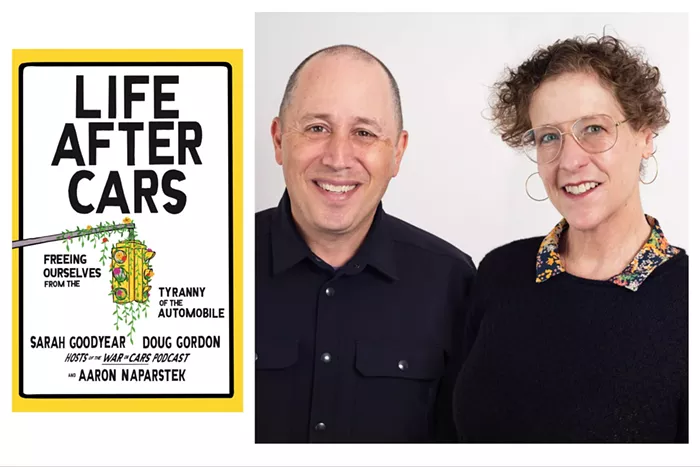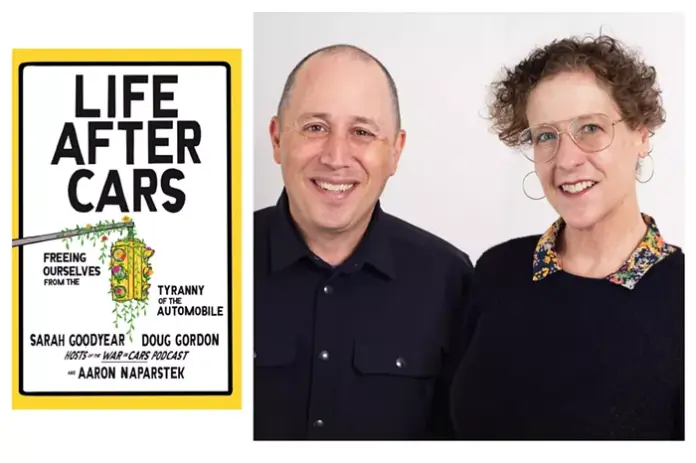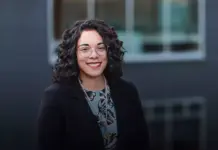This post was originally published on this site

This story originally appeared in our sister publication, Portland Mercury.
“Cars ruin everything.”
That’s the bold opening line of Life After Cars, the new book by celebrated transportation media figures Sarah Goodyear, Doug Gordon, and Aaron Naparstek. The writers make a case for that initial assertion, detailing the various ways cars—or, more specifically, car culture as we currently know it—ruin childhoods, destroy wildlife, perpetuate societal injustices, and kill people, to name a few particularly negative effects.
But, as its title suggests, Life After Cars also contains a hopeful side, asking readers to imagine how humans could thrive in a post- automobile world. Seattleites have a chance to hear about this directly, from Goodyear and Gordon, at an upcoming Town Hall Seattle reading.
Brooklynites Goodyear, Gordon, and Naparstek, whose backgrounds include a mix of transportation journalism and advocacy, are best known for hosting the popular War on Cars podcast. The trio launched the podcast in 2018 with the goal of bringing transportation coverage to the masses. (Naparstek is no longer a War on Cars co-host.)
“We did not want to make a super wonky podcast,” Goodyear told the Mercury during a recent Zoom conversation, which included her co-author Gordon. “We wanted to make a podcast that would get these issues out into the world to show people how connected everything is, and how transportation is connected to everything else. If there’s a problem that you’re interested in, cars probably have something to do with that problem in one way or another.”
The podcast’s title is a tongue-in-cheek reference to fear-mongering slogans politicians and the media employ at the thought of policies that don’t center the personal automobile. The War on Cars reclaims the slogan somewhat ironically, but its hosts are genuine about the fight against the car culture dominating cities in the United States and around the world. In the book, the authors write they wanted the name of the podcast to “reflect the idea that cars are, without exaggeration, one of the most significant and negative environmental, political, social, and cultural forces in the history of humanity.”
Life After Cars emerged out of a desire to explain the “tyranny of the automobile,” as the authors put it, in an accessible way. Compared to the podcast’s deep-dives, the book serves as a birds-eye view of the ways cars have ruined society and what we can do to reverse course. But for a book that’s shorter than 250 pages, it’s impressively comprehensive.
“The idea is to have a book that will work for people who know about these issues, and be able to surprise them and connect things for them and make them feel empowered and connected to other people doing the work,” Goodyear said. “But at the same time, [we wanted it] to reach outside of that to people who might never have thought about these things consciously, but who are interested in learning and growing and seeing things in a new way.”
Those new to thinking about the automobile’s reign of terror on society might bristle at the book’s explicitly anti-car message, but the authors aren’t throwing around assertions they can’t back up. By covering a range of topics in one volume, Life After Cars provides openings for new people to enlist in the (proverbial) war on cars.
Parents of young children may be particularly intrigued by the chapter that details how cities built for cars have effectively sapped opportunities for childhood independence, forcing kids to rely on their parents’ minivans to get from place to place. Anyone aware of the crisis of climate change knows that gas-powered cars are warming the planet, but what about their more immediate impacts on the natural environment? (Think roadkill.) And everyone should be alarmed by the shocking number of human deaths and serious injuries that result from car crashes every year. (About 46,000 in the US in 2022.)
After laying out the problem, the book tackles potential solutions. The authors describe the importance of urban design that decenters cars, offering ideas for how to galvanize the political will to make such changes happen. The “Do It Yourself” chapter is particularly interesting, explaining the strategy of “tactical urbanism,” in which everyday people take to the streets to make the changes their city officials won’t. Such a technique “turns abstract concepts or renderings of how streets should look, feel, and function into real-world demonstrations of exactly those things.”
More broadly, Life After Cars gives readers permission to imagine a new way of living, reminding us that change is possible. After all, cars haven’t even been around for 150 years.
Goodyear and Gordon say that—despite the Trump administration’s explicit desire to keep cars at the top of the traffic hierarchy in the US—they’ve seen an encouraging cultural turn away from car culture over the last few years.
“It took about 100 years, and a lot of different forces, including highway builders, car companies, and governments, to get to the point where we’re at now. And it’ll take a long time to turn back. ” Gordon said. “But you just keep going, and then things change. And you see that when you do change things, they often get accepted very quickly.”
Life After Cars shows that change often starts small. There’s a shoutout to Portland’s “Coach” Sam Balto, whose bike bus at Alameda Elementary School is a viral sensation on TikTok, inspiring others to think about how to make streets safer for kids. The authors also point out the changes that accompanied the pandemic, when people embraced open streets and on-street dining with a newfound fervor.
“Are we going to change everything in the next 20-30 years? No, but could you get a bike lane on your street that takes you to where you work or go to school? Yeah, that could happen, very quickly,” Gordon said. “We face great headwinds because of the political situation nationally, but I do think there are little green shoots everywhere you look.”
Life After Cars’ message is encapsulated by its evocative jacket art depicting a stoplight and a car, clearly out of use, overgrown with vines and flowers. The art echoes post-post-apocalyptic imagery, in which nature has retaken its rightful place amid the derelict remnants of humanity. But Goodyear, Gordon, and Naparstek suggest humanity can persevere—it’s just the cars that need to go.
“We don’t have to live like this, and we don’t have to wait for permission to initiate change,” the authors write. “Welcome to the war on cars.”
Sarah Goodyear & Doug Gordon appear in conversation with CityNerd creator Ray Delahanty at Town Hall Seattle, 1119 Eighth, Wed Nov 5, 7:30 pm, SOLD OUT but can be watched remotely. And at a book signing and author talk at Cascade Bicycle Club, 7877 62nd, Thurs Nov 6, 7 pm, $10 w/ donation option, tickets here (this talk is open to the public, but unregistered users will need to make an account).



















